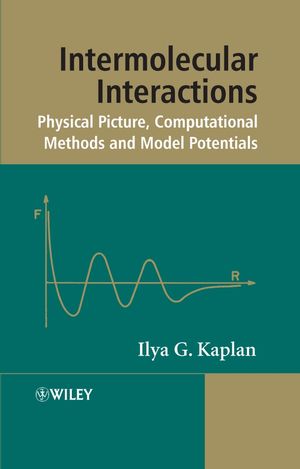Intermolecular Interactions: Physical Picture, Computational Methods and Model PotentialsISBN: 978-0-470-86332-9
Hardcover
384 pages
May 2006
 This is a Print-on-Demand title. It will be printed specifically to fill your order. Please allow an additional 10-15 days delivery time. The book is not returnable.
|
||||||
1 Background Knowledge.
1.1 The Subject and its Specificity.
1.2 A Brief Historical Survey.
1.3 The Concept of Interatomic Potential and Adiabatic Approximation.
1.4 General Classification of Intermolecular Interactions.
References.
2 Types of Intermolecular Interactions: Qualitative Picture.
2.1 Direct Electrostatic Interactions.
2.2 Resonance Interaction.
2.3 Polarization Interactions.
2.4 Exchange Interaction.
2.5 Retardation Effects in Long-Range Interactions and the Influence of Temperature.
2.6 Relativistic (Magnetic) Interactions.
2.7 Interaction Between Macroscopic Bodies.
References.
3 Calculation of Intermolecular Interactions.
3.1 Large Distances.
3.2 Intermediate and Short Distances.
References.
4 Nonadditivity of Intermolecular Interactions.
4.1 Physical Nature of Nonadditivity and the Definition of Many-Body Forces.
4.2 Manifestations of Nonadditive Effects.
4.3 Perturbation Theory and Many-Body Decomposition.
4.4 Many-Body Effects in Atomic Clusters.
4.5 Atom–Atom Potential Scheme and Nonadditivity.
References.
5 Model Potentials.
5.1 Semiempirical Model Potentials.
5.2 Determination of Parameters in Model Potentials.
5.3 Reconstructing Potentials on the Basis of Experimental Data.
5.4 Global Optimization Methods.
References.
Appendix 1: Fundamental Physical Constants and Conversion Table of Physical Units.
Appendix 2: Some Necessary Mathematical Apparatus.
A2.1 Vector and Tensor Calculus.
A2.1.1 Definition of vector; the addition law.
A2.1.2 Scalar and vector products; triple scalar product.
A2.1.3 Determinants.
A2.1.4 Vector analysis; gradient, divergence and curl.
A2.1.5 Vector spaces and matrices.
A2.1.6 Tensors.
A2.2 Group Theory.
A2.2.1 Properties of group operations.
A2.2.2 Representations of groups.
A2.2.3 The permutation group.
A2.2.4 The linear groups. The three-dimensional rotation group.
A2.2.5 Point groups.
A2.2.6 Irreducible tensor operators. Spherical tensors.
References.
Appendix 3: Methods of Quantum-Mechanical Calculations of Many-Electron Systems.
A3.1 Adiabatic Approximation.
A3.2 Variational Methods.
A3.2.1 Self-consistent field method.
A3.2.2 Methods taking into account the electron correlation.
A3.2.2.1 r12-dependent wave functions.
A3.2.2.2 Configuration interaction.
A3.2.2.3 Coupled cluster method.
A3.2.2.4 Density functional theory approach.
A3.3 Perturbation Theory.
A3.3.1 Rayleigh–Schr¨odinger perturbation theory.
A3.3.2 Møller–Plesset perturbation theory.
A3.3.3 Operator formalism and the Brillouin–Wigner perturbation theory.
A3.3.4 Variational perturbation theory.
A3.3.5 Asymptotic expansions; Padé approximants.
References.
Index.



